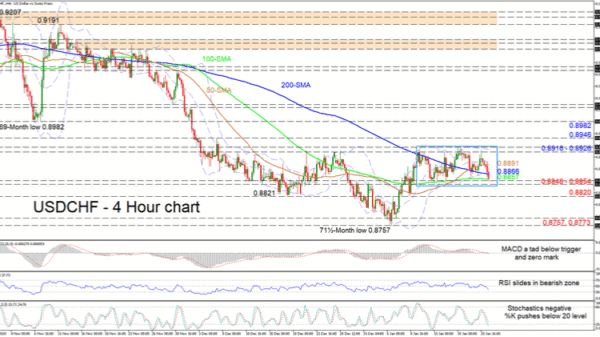USDCHF has poked back underneath the 200- and 100-period simple moving averages (SMAs) at 0.8866 and 0.8857. Its recent attempts to decisively surpass the 200-period SMA have ended up consolidating the price around it, thus keeping hopes of the bear market alive. The flattening 100-period SMA and the falling 200-period SMA, as well as the slowing upward pace of the 50-period SMA, all as a whole, are endorsing the sideways move.
The short-term oscillators, which are leaning towards the downside, are indicating that negative momentum is gaining strength and could fuel the broader bearish bias. The marginal dip of the MACD below its red trigger line and the zero mark seems to be signalling price frailty. Furthermore, the stochastic %K line has pierced below the 20 mark promoting additional declines, while the RSI is falling in bearish territory.
If the pullback manages to sink beneath this key floor, of the recent sideways move, of 0.8846-0.8854, sellers may find rest at the 0.8820 trough. However, should more severe price deterioration unfold, the 0.8773 and 0.8757 lows, the latter being a multi-year bottom, could quickly step into the spotlight.
On the other hand, a rebound off the 0.8846-0.8854 boundary could prove to be strong traction for the pair to steer towards the proximity of the 50-period SMA and the mid-Bollinger band, around 0.8891. Extending the drive upwards may then encounter tough resistance from a region of multiple highs from 0.8916 to 0.8926. Successfully overcoming the upper Bollinger band, the price could target the nearby 0.8946 high before catapulting towards the 0.8982 barrier.
Summarizing, USDCHF retains an overwhelming broader bearish bias. However, taking a closer look at latest trading, a break either above 0.8926 or below 0.8846 could pave the next clear price path.














